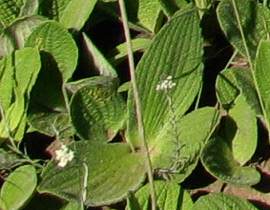Helichrysum nudifolium var. pilosellum
Helichrysum nudifolium (L.) Less. var. pilosellum (L.f.) Beentje
Family: Asteraceae
Common names: hairy everlasting (Eng.); bolebo, boleba-ba-liliba, leboko, papetloane-ea-liliba, papetloane-e-kholo, tsebe-litelele (South Sotho); isicwe (Xhosa, Zulu?); umadotsheni, umaphephesa (Zulu )
Introduction
Helichrysum nudifolium var. pilosellum occurs in the open grassland of the Free State, and grows from Eastern Cape to Malawi. The plant's most attractive feature is its bright golden yellow flowers.

Description
Description
Helichrysum nudifolium var. pilosellum is a perennial herb up to 400 mm tall, with a long woody flowering stem arising from a woody rootstock. The leaves are simple with an entire margin, dark green, ovate with a broad base, having a parallel vein and rough hairs. The leaves cluster from the base. The flower head is 5 x 5 mm with a woolly stem. The flowers attract different insects. Fluffy seeds are dispersed by wind or rain. The flowering time is from October to March.


Conservation Status
Status
Helichrysum nudifolium var. pilosellum is not listed in the Southern African plant Red Data Lists (Golding 2002).
Distribution and habitat
Distribution description
Helichrysum nudifolium var. pilosellum occurs at high altitudes in grassland from Eastern Cape, Limpopo, North-West, Mpumalanga and Free State, and in Malawi and Lesotho. The species grows in full sun, and thrives in dry conditions.
Derivation of name and historical aspects
History
The genus Helichrysum was named by Philip Miller (1691-1771), a British gardener, who was superintendent of the Society of Apothecaries, Chelsea Physick Garden, from 1722 to 1770. The genus name Helichrysum comes from the Greek words, helios, meaning sun, and chrysos, meaning gold. The variety name, pilosellum, means having shaggy hairs.
Ecology
Ecology
The flowers of Helichrysum nudifolium var. pilosellum attract lots of small insects such as bees, flies and beetles which pollinate them when moving from one to the other. Seed dispersal is by water or wind.

Uses
Use
Helichrysum nudifolium var. pilosellum is used as an ingredient in a colic remedy. The Basotho people use it as a herbal tea, as well as for childbirth problems and infertility. Horticulturally, it is a good perennial garden plant which produces bright golden yellow flowers for more than six months.
Growing Helichrysum nudifolium var. pilosellum
Grow
Sow freshly gathered seeds or store them for sowing in the summer. Mix 50% sand or silica with 50% seedling mixture, which allows for good drainage. Mix the seeds with soil before sowing, or sow them first and cover with very fine soil. The container should provide good water drainage and be placed under moderate mist. The seeds will germinate within four weeks. Harden off the plants and after two weeks transplant them into 2-litre bags. In the display bed, plant the seedlings 20 cm apart in full sun. The plants may be multiplied through the splitting or division of the mother stock, but be careful not to disturb the roots.
References
- Arnold, T.H. & De Wet, B.C. (eds). 1993. Plants of southern Africa : names and distribution. Memoirs of the Botanical Survey of South Africa No. 62.
- Germishuizen, G. & Fabian, A. 1997. Wildflowers of northern South Africa. Fernwood Press, Vlaeberg, Cape Town.
- Germishuizen, G. & Meyer, N.L. (eds). 2003. Plants of southern Africa : an annotated checklist. Strelitzia 14. National Botanical Institute, Pretoria.
- Golding, J.S. (ed.). 2002. Southern African plant Red Data Lists. Southern African Botanical Diversity Network Report No. 14. SABONET, Pretoria.
- Pooley, E. 1998. A field guide to the wild flowers of KwaZulu-Natal and the Eastern Region. Natal Flora Publications Trust, Durban.
- Pooley, E. 2003. Mountain flowers, a field guide to the flora of the Drakensberg and Lesotho. The Flora Publications Trust, Durban.
- Smith, C.A. 1966. Common names of South African plants. Memoirs of the Botanical Survey of South Africa No. 35.
- Watt, J.M. & Breyer-Brandwijk, M.G. 1962. The medicinal and poisonous plants of southern and eastern Africa. Livingstone, Edinburgh and London.
Credits
Luambo David Rambuwani
Free State National Botanical Garden
March 2009
Plant Attributes:
Plant Type: Perennial
SA Distribution: Eastern Cape, Free State, Limpopo, Mpumalanga, North West
Soil type:
Flowering season: Spring, Early Summer, Late Summer
PH:
Flower colour: Yellow
Aspect: Full Sun
Gardening skill: Average
Special Features:
Horticultural zones









Rate this article
Article well written and informative
Rate this plant
Is this an interesting plant?
Login to add your Comment
Back to topNot registered yet? Click here to register.